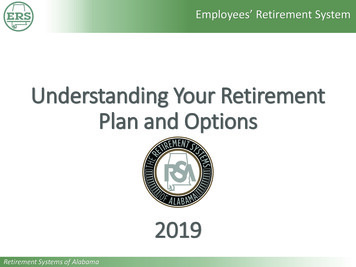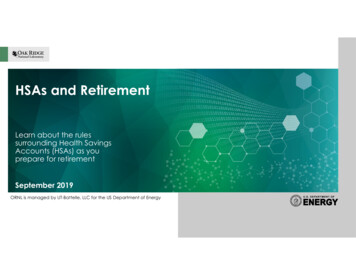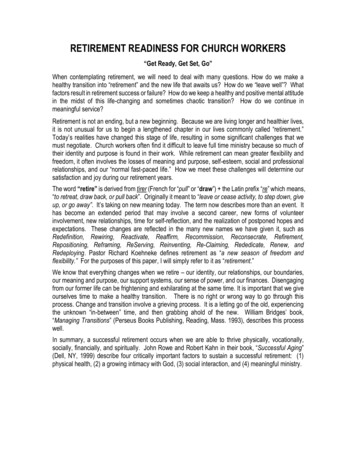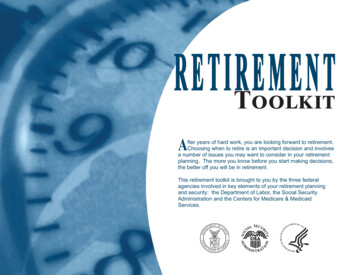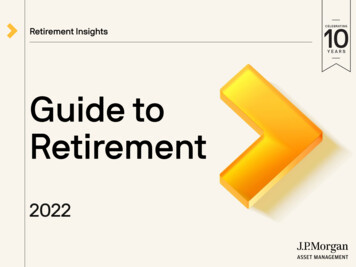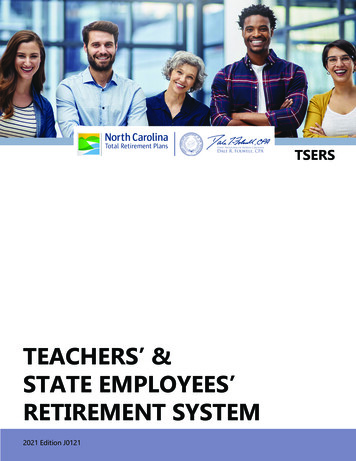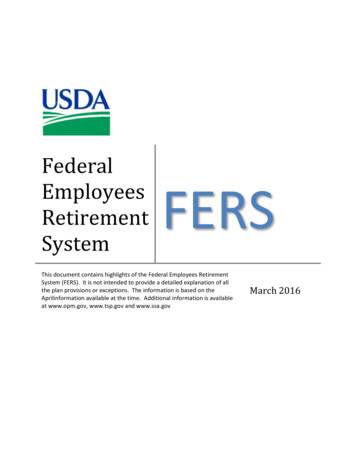
Transcription
FederalEmployeesRetirementSystemFERSThis document contains highlights of the Federal Employees RetirementSystem (FERS). It is not intended to provide a detailed explanation of allthe plan provisions or exceptions. The information is based on theAprilinformation available at the time. Additional information is availableat www.opm.gov, www.tsp.gov and www.ssa.govMarch 2016
IntroductionMost people look forward to retirement as a rewarding time. But, a rewarding retirementdoesn’t just happen. In takes careful planning. Knowing when you can retire andunderstanding your Federal retirement benefits are an important part of the planning process.Your future financial security depends, in part, on the decisions you make today.The Federal Employees Retirement System (FERS) covers most new, non-temporary employeeshired on or after January 1, 1984. FERS is a retirement system that is responsive to theemployee’s needs and decisions. Many of its features are “portable,” so if you leave Federalemployment, you may still qualify for the benefits. FERS enables you to take an active role insecuring your future. Therefore, it is important for you to understand the features and benefitsof the retirement program, so you can make wise financially sound decisions now inpreparation for your retirement. This booklet highlights the main features of the FederalEmployees Retirement System (FERS).The US Department of Agriculture (USDA) provides you with a Personal Benefit Statementhighlighting your employee benefits coverage and costs. The benefits statement is located onthe Employee Personal Page (EPP) and is updated annually. This is an excellent document tokeep with your will or to take with you to your personal financial planner as a planning tool forthe future.Components of your RetirementFERS is a three-tiered retirement system, providing retirement income from three separatesources. The three components are: FERS Basic AnnuityThrift Savings Program (TSP)Social Security BenefitsThese three components work together to provide you a strong financial foundation for yourretirement years.1
FERS Basic Annuity PlanCoverage under the FERS basic annuity plan is determined by when and how you were hired.New employees first hired in permanent or TERM positions on or after January 1, 1984 arecovered under the FERS retirement system.You should verify your retirement coverage by reviewing your Personal Benefits Statement onEPP, reviewing your Earnings and Leave Statement, or reviewing your Notification of PersonnelAction, Standard Form (SF) 50, block 30. You can locate the SF-50 form in your electronicOfficial Personal Folder (eOPF). If you have any questions about how to locate and review youreOPF, contact your servicing HR office.In Block 30 of the SF-50 the following retirement codes indicate a FERS retirement plan:Potential FERS Retirement Plans K – FERS and FICA (Federal Insurance Contributions Act (Social Security))KR – FERS-RAE (Revised Annuity Employees) and FICAKF – FERS-FRAE (Further Revised Annuity Employees) and FICAM – FERS and FICA –Special (for Firefighter and Law Enforcement Officers)MR – FERS-RAE and FICA – Special (for Firefighter and Law Enforcement Officers)MF – FERS-FRAE and FICA – Special (for Firefighter and Law Enforcement Officers)Sample of center section of SF-50:Why are there so many different retirement codes for FERS? The different retirementcodes indicate different payroll deduction percentage amounts. The difference is determinedby when you were hired and the type of position you were hired into. For example, firefightersand law enforcement officers must pay a .5% higher contribution towards retirement becausethey can retire earlier than most employees and have a mandatory retirement age of 57. Inaddition, in 2013 and 2014 Congress increased the retirement contribution percentages fornew employees. This also resulted in new retirement codes for the different contribution rates.2
FERS Contribution Rates:CategoryFERS Regular EmployeesFERS-Special Firefighters &Law Enforcement OfficersFERS-RAE RegularEmployeesFERS-RAE - SpecialFirefighters & LawEnforcement OfficersFERS-FRAE RegularEmployeesFERS-FRAE - SpecialFirefighters & LawEnforcement %AgencyContribution11.9%26.3%ApplicableHire KF4.4%9.6%MF4.9%22.7%2014 –present2014 presentNote: If you had breaks in service your retirement codes may be different than listed above. Ifyou have questions or concerns about your retirement code, do not hesitate contacting yourbenefits specialist in your servicing HR office for verification.Key Point: Because there are many different retirement codes and deduction rates, eachemployee should verify the retirement code on their SF-50 appears accurate AND thecontribution rate is correctly deducted on their Earnings and Leave Statement. Simply multipleyour gross pay by the corresponding employee contribution percentage above. If there is anerror or a concern, please call your servicing HR office.Creditable Service for RetirementCreditable service means the amount of service used to calculate your retirement eligibility oryour retirement annuity. Years and full months of creditable service are added together andused in the retirement calculation. To determine your length of service for computation, addall of your periods of creditable service, then eliminate from the total any fractional part of amonth (less than 30 days).Service that may be creditable towards retirement generally includes: Federal civilian service for which contributions have been made or deposited.Military service, if a deposit is complete. To receive credit for military service, generally,you must deposit 3% of your military base pay. Interest begins to accrue 2 years afteryou are hired. With certain exceptions, you cannot receive credit for military service ifyou are receiving military retired pay. National Guard service is normally not creditable,3
except when ordered to active duty in the service of the United States. However, thereare rare circumstances when you may receive credit for National Guard service afterAugust 1, 1990, if it is followed directly by Federal civilian reemployment. If you thinkthis provision applies to you, please contact a Benefits Specialist at your servicing HRoffice.Leaves of absence for performing military service or while receiving workers’compensation.Unused sick leave. (Sick leave is creditable for the annuity computation only. Sick leavecannot be used to determine retirement eligibility.)Non-deduction service prior to 1/1/1989, if a deposit is made.Service Computation DatesThe Service Computation Date (SCD) determines an employee’s eligibility for a specific benefitor entitlement. There are four different types of SCDs: Leave, Retirement, Thrift Savings Plan,and Reduction-In-Force (RIF). Leave SCD determines the amount of annual leave earned per pay period: four, six, oreight hours. It is shown in block #31 of the Standard Form (SF) 50. This SCD includesmost military service, unless you are retired military, even if you haven’t made themilitary deposit. The rules of computing this SCD are found in the Guide to ProcessingPersonnel Actions, Chapter 6.Note: Only your Leave SCD appears on the SF-50. TSP SCD is used to determine when you become vested in TSP. Vesting means thatyou are entitled to keep your Agency Automatic (1%) Contributions (and their earnings)after you’ve completed a time-in-service requirement. Most FERS employees are vestedin TSP after 3 years of service. All Federal civilian service time is included in this SCD. RIF SCD is one of the factors used to determine an employee’s retention if there was aReduction in Force at the agency.4
Retirement SCD includes the service that is creditable in determining if you are eligiblefor retirement. Your retirement SCD is often the date when you were first coveredunder FERS. The retirement SCD may be adjusted if a deposit is made for non-deductionservice before 1989 or military service. The retirement SCD is used to determineretirement eligibility and therefore, does not include sick leave. Sick leave is used in theretirement annuity computation, but not to determine eligibility for retirement. Timenot creditable for retirement that may affect the Retirement SCD: Excess leave without pay (LWOP)Federal service requiring a deposit that has not been paidTemporary service performed after 1989 (FERS only)Breaks in Federal service in excess of three daysMilitary service with an unpaid depositVesting in FERSVesting means you have a current or future right to receive a FERS basic annuity. To be vestedin the FERS basic annuity you must have at least 5 years of creditable civilian service.Employees are eligible for disability benefits after 18 months of civilian service. Once you arevested you can receive a retirement annuity even if you leave Federal service, provided you didnot receive a refund of your retirement contributions after you separated.Refund of ContributionsYou may withdraw your basic FERS retirement contributions if you leave Federal employment.If you withdraw your retirement contributions, you will not be eligible to receive a retirementannuity for the service period refunded. This refunded service period may only becomecreditable towards your retirement annuity if you are reemployed and redeposit the refundedamount (plus interest) while reemployed.5
FERS Retirement EligibilityEligibility is determined by your age and number of years of creditable service worked as notedin your retirement SCD. In most cases you must have at least reached the Minimum RetirementAge (MRA) to be eligible for retirement.Minimum Retirement Age:If you were born:Your MRA is:Before 1948In 1948In 1949In 1950In 1951In 1952In 1953 through 1964In 1965In 1966In 1967In 1968In 1969In 1970 and after5555 and 2 months55 and 4 months55 and 6 months55 and 8 months55 and 10 months5656 and 2 months56 and 4 months56 and 6 months56 and 8 months56 and 10 months57Immediate Voluntary RetirementAn immediate retirement benefit is one that starts within 30 days from the date you stopworking. If you meet one of the following sets of age and service requirements, you are entitledto an immediate retirement benefit:Age6260MRAMRAYears ofService5203010** Age Reduction: If you retire at the MRA with at least 10 years of service, but less than 30years of service, your annuity will be reduced by 5% a year for each year you are under 62,unless you have 20 years of service and your benefit starts when you reach age 60 or later.6
Early RetirementVoluntary early retirement (VERA) and discontinued service retirement (DSR) are only availablein certain involuntary separation cases and in cases of voluntary separations during a majorreorganization or reduction-in-force, if proper authority is obtained from OPM. You must meetthe following requirements:Age50Any ageYears ofService2025Deferred or Postponed RetirementDeferred or postponed retirement refers to delaying the date your retirement annuity begins.A deferred retirement occurs when you are not eligible for immediate retirement and have atleast 5 years of service. If you resign before you meet the age and service requirements for animmediate retirement benefit, you may be eligible for deferred retirement benefits when youreach the age requirements for the voluntary retirement benefits mentioned above. Youcannot reinstate Federal Employee Health Benefits (FEHB) or Federal Employee Group LifeInsurance (FEGLI) if you retire under a deferred retirement.A postponed retirement is available if you have reached the MRA with at least 10 years ofservice, but you do not have enough years of service to meet the requirements for a voluntary,unreduced retirement. You can elect to delay the annuity start date to avoid or reduce the agereduction. By waiting to apply for retirement until you are age 62 (or age 60 with 20 years ofservice) your annuity will not be reduced. If you are eligible for a postponed retirement youmight be eligible to reinitiate FEHB and/or FEGLI coverage in retirement, if you meet all theother requirements.Disability RetirementYou may be eligible for a disability retirement if you become disabled, because of a disease orinjury, while in a position covered by FERS. The disability must be expected to last at least oneyear. Your agency must certify that it is unable to accommodate your disabling medicalcondition in your present position and that it has considered you for any vacant position in thesame agency at the same grade/pay level, within the same commuting area, for which you arequalified for reassignment. OPM makes the final determination if the employee qualifies fordisability retirement based upon the documentation submitted.AgeAny ageYears ofService18 months7
FERS Annuity ComputationYour FERS annuity is based on your years of creditable service (as described above) and youraverage pay for your three highest paid consecutive years. Although accrued sick leave cannotbe used to determine your retirement eligibility, sick leave is added to your years of service tocompute your retirement annuity.High-3 Average Pay is the highest three consecutive years of basic pay. This is usually the lastthree years of your pay before you retire, but not always. Your basic pay is the basic salary youearn for your position and includes locality pay (if applicable). It also includes increases to yoursalary for which retirement deductions are withheld, such as shift rates. It does not includepayments for overtime, bonuses, etc.Voluntary Retirement Annuity Computation:High-3AverageSalaryYears ofservice1%AnnualAnnuityIf you retire at age 62 or later with at least 20 years of eligible service, a factor of 1.1% is usedrather than 1%. Your benefits will be reduced if you retire under MRA 10 retirement rules, asstated under the voluntary retirement section.Your retirement annuity continues from the date of retirement until you die. If you elect aspousal annuity, and you die before your spouse, the spousal annuity continues until yourspouse dies.Firefighters and Law Enforcement OfficersTo qualify for firefighter and law enforcement retirement benefits you must meet all of thequalifications, including: 20 years of service under the “special” retirement coverage,3 years in a primary position, andIf you are in an approved secondary position, there cannot be any breaks in specialretirement coverage between the primary and secondary position. You must havemoved directly from the primary position to the secondary position. Nor can there beany breaks in the special retirement coverage between any secondary positions.8
Employees covered under the FERS special retirement may elect to retire at age 50 with 20years of service, or at any age with 25 years of service without an age reduction. They are alsosubject to a mandatory retirement at age 57 if they are under the special retirement coverageat the time. If you are in one of these employee groups, you contribute an additional .5% ofyour pay to the Federal Employees Retirement System (FERS).Your annual annuity is computed as follows:High-3 average salary X 1.7 % x 20 years of serviceplusHigh-3 average salary x 1% x years of service exceeding 20You also receive a Special Retirement Supplement (discussed below) from the date ofretirement until age 62 that approximates the Social Security benefit earned from your Federalservice. After you reach the Minimum Retirement Age (MRA), if you have earnings from wagesor self-employment that exceeds the Social Security annual exempt amount, your supplementwill be reduced or stopped. You are also entitled to an annual Cost-of-Living Adjustment(COLA), regardless of your age.Part-Time EmployeesRetirement annuities are based on an employee’s length of service and the highest annual basepay received for any three consecutive years. Each year of part-time service counts as one fullyear toward the eligibility for retirement. However, the annuity calculation for periods of parttime service is prorated to reflect the difference between full-time and part-time service. Forexample, if you worked for 30 years, with 2 years of those years as a part time employeeworking 20 hours per week, your retirement eligibility is based on the full 30 years of service.However, the annuity is computed as:High-3 average salary x 1% x 28 yearsplusHigh-3 average salary x 1% x (2 years x 50%)9
Special Retirement SupplementThe FERS annuity supplement is a temporary benefit paid in addition to gross monthly FederalEmployees Retirement System (FERS) annuity benefits. It represents approximately what youwould receive from the Social Security Administration (SSA) for your FERS civilian service if youwere eligible to receive SSA benefits on the day you retired. Eligibility for the annuitysupplement usually continues until age 62.If you retire voluntarily on an immediate annuity which is not reduced for age (MRA 10), youmay be eligible for the annuity supplement in addition to your regular monthly FERS benefit.You may also receive the supplement if you retired involuntarily before attaining yourMinimum Retirement Age (MRA) or voluntarily because of a major reorganization, reduction-inforce, or an early retirement for Members of Congress. However, in these three instances, youwill not be eligible for the annuity supplement until you reach your Minimum Retirement Age(MRA). If you receive a deferred annuity, a disability annuity or an immediate MRA 10 annuity,you will not be eligible for the annuity supplement.Like social security benefits, the FERS annuity supplement is subject to an earnings test. TheFERS annuity supplement is reduced if you earn more than the Social Security earnings limit inthe prior year. The Social Security earnings limit for 2016 is 15,720. The FERS annuitysupplement is reduced by 1.00 for every 2.00 of earnings over this earning limit. It is possiblethat the supplement could reduce to 0. However, the FERS basic benefit will not be reduced.If you are receiving a supplement, you must report your earnings to OPM. The reduction forexcess earnings does not apply to employees who retire under the special provisions for lawenforcement officers or firefighters until they reach the MRA.Disability Retirement AnnuityFERS disability benefits are computed differently depending on the annuitant’s age and years ofcreditable service at retirement. In addition, FERS disability retirement benefits arerecomputed after the first twelve months and again at age 62, if the annuitant is under age 62at the time of disability retirement.FERS Disability computation if you are age 62 or eligible for an immediate voluntaryretirement:AgeFormulaIf age 62 or older at retirement with less than High-3 average salary x 1% x years of service20 years of service, ORunder age 62 qualified for an immediatevoluntary retirementIf age 62 or older with 20 or more years ofHigh-3 average salary x 1.1% x years of serviceservice10
FERS Disability computation if you are under age 62 and not eligible for animmediate voluntary retirement:DurationFormulaFirst 12 monthsHigh-3 average salary x 60% minus 100% ofSocial Security benefitsAfter 12 months until you are 62High-3 average salary x 40% minus 60% ofSocial Security benefitsWhen you reach age 62 your annuity will be recomputed using an amount that essentiallyrepresents the annuity you would have received if you had continued working until the daybefore your 62nd birthday and then retired under FERS. The total service used in thecomputation will be increased by the amount of time you received a disability annuity. Plus theaverage salary used in the computation will be increased by all FERS cost-of-living increasespaid during the time you received a disability annuity. If you are a disability retiree under age60 and your total income from work in a calendar year exceeds 80%
FERS Basic Annuity Plan Coverage under the FERS basic annuity plan is determined by when and how you were hired. New employees first hired in permanent or TERM positions on or after Janu



